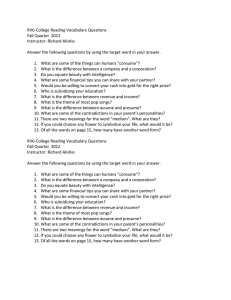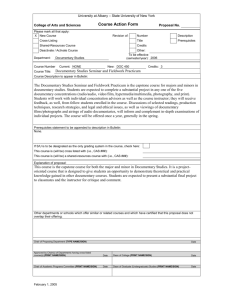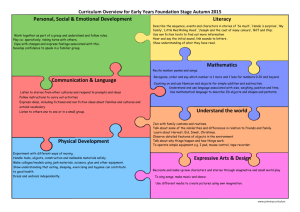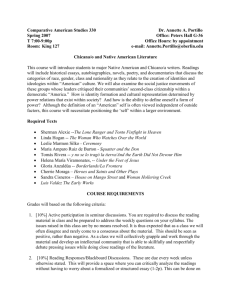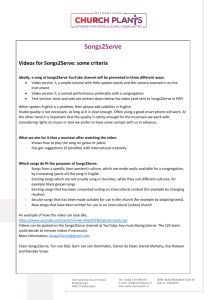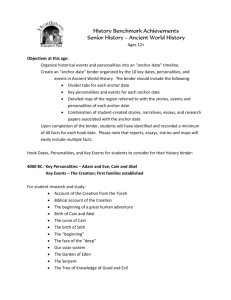The American Civil War
advertisement
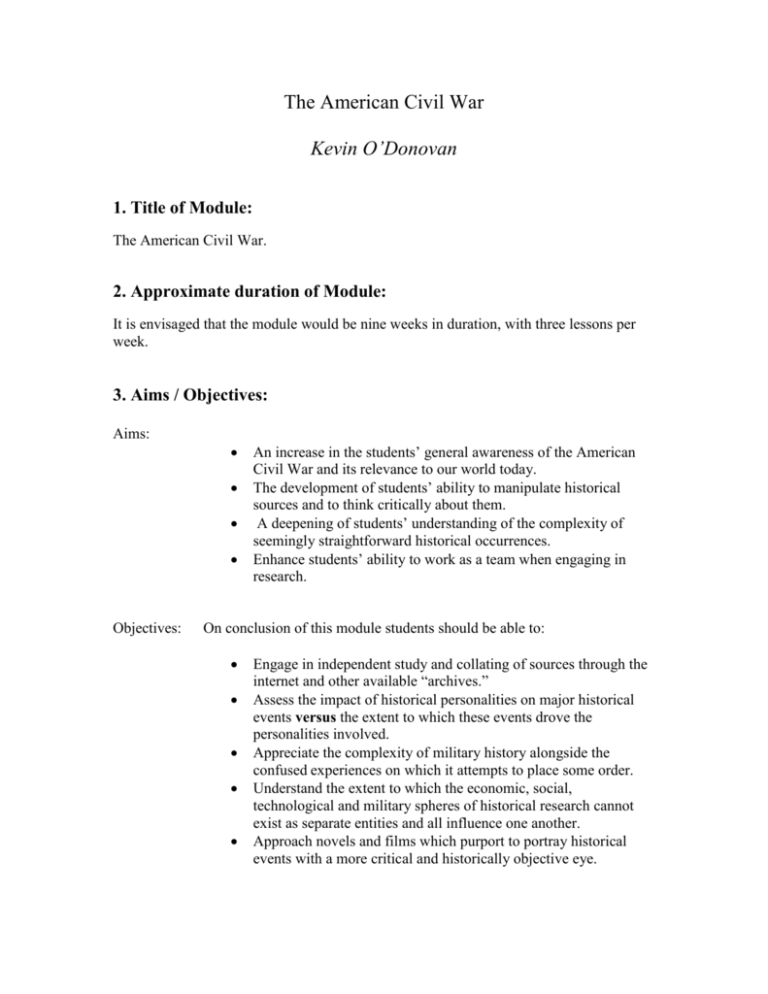
The American Civil War Kevin O’Donovan 1. Title of Module: The American Civil War. 2. Approximate duration of Module: It is envisaged that the module would be nine weeks in duration, with three lessons per week. 3. Aims / Objectives: Aims: Objectives: An increase in the students’ general awareness of the American Civil War and its relevance to our world today. The development of students’ ability to manipulate historical sources and to think critically about them. A deepening of students’ understanding of the complexity of seemingly straightforward historical occurrences. Enhance students’ ability to work as a team when engaging in research. On conclusion of this module students should be able to: Engage in independent study and collating of sources through the internet and other available “archives.” Assess the impact of historical personalities on major historical events versus the extent to which these events drove the personalities involved. Appreciate the complexity of military history alongside the confused experiences on which it attempts to place some order. Understand the extent to which the economic, social, technological and military spheres of historical research cannot exist as separate entities and all influence one another. Approach novels and films which purport to portray historical events with a more critical and historically objective eye. 4. Teaching and Learning Strategies: Video footage from both historical documentaries and Hollywood films may be used for large parts of the course. Not only will this add some excitement to the classes, but it should add to students awareness of how events may have looked and how accurately they are portrayed in studio films. Compact Discs with recordings of Civil War songs should be used, not only as a means of “setting the scene,” for students but also to suggest the many different levels at which the war was fought and the impact of propaganda. Access to school I.T. facilities and webquests can be utilised as a means of promoting independent learning among students. Webquests should be adapted to the age level undertaking the module. Their use of the internet as a means of gaining access to historical sources should be central to the assessment by project work at the end of the module. Team teaching is an option, especially through the Transition Year programmes in English, Music, Science and I.T. Use of Overheads, photocopies and board in order to give the class visual and written sources about the personalities being discussed along with the geographical regions encountered. A range of short excerpts from Civil War novels to be read and discussed by students in class, comparing them to the more historical accounts to be encountered. Class debates will be used to discuss the major issues which led to the outbreak of the war. Class division will be utilised, with one side taking the North’s point of view while the other takes the South’s. Participants from either side will be combined for project work at the end of the module. 5. Content: It is envisaged that each of these topics will take approximately one to two periods each, at the teacher’s discretion. (a) Where?What?When? – A general discussion of the America that existed prior to the Civil War. This should help to lay the seeds for issues which will crop up later, such as the cotton based economy of the South etc. (b) Who? – Exploration of the major political leaders, their beliefs and backgrounds – Lincoln and Davis in particular. (c) Why? – The major issues which caused the war (students can be surprised by the extent to which slavery is “covered up” by the two sides for varying reasons). (d) Outbreak, early leaders + an early battle. (e) Technological innovations of the Civil War – Developments like the submarine and the Ironclads will be examined here. There’s a story in “In the Midst of Life” by Ambrose Bierce about one of the early Ironclad battles, along with large amounts of material in “The Illustrated History of the Civil War” and the documentary series which I will mention under resources. (f) At home during the war – A discussion of the home front supported by examples from “Gone With the Wind,” and directed research on the net. (g) The music of the Civil War – A look at some of the popular songs of the period and their origins. (h) Grant and Lee – Research on the two generals – their backgrounds, their rise, their differing philosophies. All this to be supported by excerpts from “The Killer Angels” and the documentary series. (i) Gettysburg – Again, using the documentary series, a number of extracts from “Glory” “Gettysburg” and “The Killer Angels” with assignments on visiting the various internet sites associated with the battle and a discussion and dissection of Lincoln’s subsequent speech. (j) The Civil War and Fiction – An introduction to the idea of using fiction and examining it for historical purposes. Equally, looking at how fiction can distort or enhance the truth of what actually occurred. (k) Spies and Prisoners – A look at the role of spies in the war, particularly female spies and also the conditions of P.O.W.s on either side. Possibilities exist here for comparison between Andersonville and the concentration camps of World War II. (l) Why the South Lost. (m) The end and the aftermath – Looking at Appomatox Reconstruction and the later lives of some of those we’ve spent time discussing. 6. Assessment: Oral questioning will be used on a continuous basis in class to examine students’ knowledge of the topic in hand. There will be regular written and oral assignments based on research on the net, work in class and examination of key documents. At the end of the module students will be expected to present a written project and do a brief oral presentation for their class. 7. Resources: Factual James M. McPherson The Battle Cry of Freedom , (Penguin). (Purely for the teacher as background information and as a general guide to the conflict , could be provided to the students occasionally in the form of brief excerpts or as a secondary source for project work) James M. McPherson / Bruce Catton The American Heritage New History of the Civil War , (Viking). (Superb illustrations and commentaries on various social and economic aspects of the war – perfect for overheads and laminated illustrations) Harper’s Pictorial History of the Civil War , (Gramercy). (Newspaper columns and illustrations from the time itself) Constance Sullivan (ed.) Landscapes of the Civil War , (Knopf). (Photographs from the 1860s) Fictional Michael Shaara The Killer Angels , (Random House). Thomas Kenneally Confederates , (Sceptre). Ambrose Bierce In the Midst of Life , (Citadel Press). Margaret Mitchell Gone with the Wind George Macdonald Frasier Flashman and the Angel of the Lord Film The Civil War (documentary series by Ken Burns) Glory (Starring Denzel Washington) Gone with the Wind Music American Civil War Music C.D. (A wide range are available on Amazon.com U.S. – try to get actual songs rather than band music as these are much more evocative) 8. Links to Other Subject: A number of possibilities exist for involving other disciplines in this module. Science is an obvious candidate when looking at the construction of some of the more innovative Civil War technologies. Music could be involved through the study of Civil War songs and melodies, their influences and context. I.T. is obviously central to many of the assessment features of this area and teachers of I.T. should be made aware of what students are attempting to achieve as it would obviously link into their own field. English could clearly take a role in looking at various types of historical sources and fictional works from a literary standpoint. 9. Evaluation: Evaluation can be conducted orally during the module and by questionnaire at the end. At the first attempt there will be parts that appeal to some classes and not to others. This is to be expected, but is no reason for discouragement – the topic is so broad and exciting, with such gigantic personalities, that anything which isn’t working can easily be jettisoned and replaced with something else. It is important that students enjoy this course and learn from it and the structure should encourage this to occur. If it doesn’t, change it!
